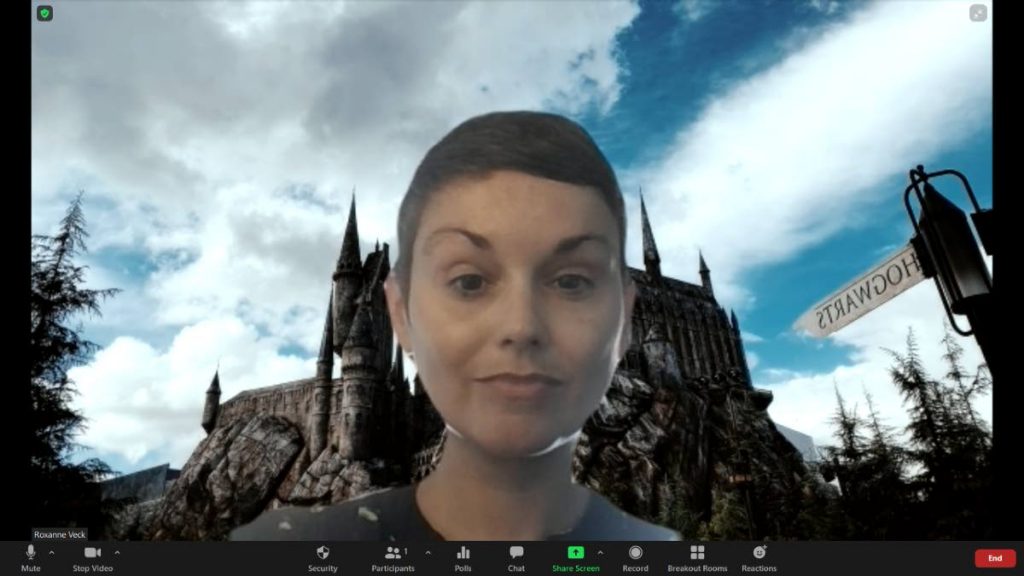Teaching students online a lesson for teachers too

When Roxanne Veck heard she would be teaching online again this school year, she headed for Hogwarts, the legendary school for witches and wizards featured in JK Rowling’s Harry Potter children’s novels.
“I spent the school year at Hogwarts,” said Vecks, a lower secondary school English teacher at the International School of Port of Spain.
Veck found the Hogwarts virtual background created an upbeat atmosphere for her classroom, now confined to a computer.
As the year progressed, there seemed to be almost a magical transformation to teaching online.
“There definitely were some benefits to teaching online,” said the British-born Veck, a teacher for the past 15 years. If you had asked her this time last year, she said, “I would have been hard-pressed to find positive points, but we became more confident over time.”
Some instruction seemed to work better online. Breakout rooms on Zoom provided quiet, reflective spaces and individualised attention for students. This focus proved impossible in a classroom filled with students.
“Some of my best interactions were one to one or in small groups in breakout rooms,” said Veck. “Students were much more willing to talk about what they were struggling with when they were placed in smaller groups.”
Online teaching, she said, “forced me to grow as a teacher and learn new technology that I will use back in the classroom. There is software where teachers can show videos and keep track of the students watching the videos, which helps monitor their involvement more.”
Veck also said Zoom helped with parent/teacher conferences.
“In school, I often only saw one parent at these meetings. Some parents found it difficult to get away from work to attend. They had to wait in line when they reached the meetings. On Zoom, I often saw both parents at meetings. They could schedule conferences to suit their schedules. The meetings were confidential.”
She plans to transfer many of the lessons learned from online classrooms into the physical one.
“Zoom teaching has opened our eyes to focusing on what is important in teaching. We focused on skill-building and rethought what is really necessary.”
Marvin Libert, a Standard Four and Five teacher at St Joseph Boys’ RC, found online teaching facilitated differentiated learning. “It’s easier to choose different sites online to facilitate student’s needs on different levels,” he said.
Home-based classes also meant parents were more involved in children’s learning.
“I found there was more parental support because parents saw the children’s classes and their behaviour in class right in front of them. We had more parents involved in Zoom meetings.”
Libert said colleagues took note of children’s behaviour in online classes.
“Teachers talked about children with discipline issues in school, and said that many of these children with discipline problems did better at home because they didn’t have the distractions and the bad behaviour around them.”
But Zoom classes had their downside too.
“Some children’s home situation is so dire,” said Libert. “It is difficult for some of the children to have classes at home or even get basic school supplies like paper.
He remembers teaching one day when a boy got up and left the class. When the student returned to the computer screen, Libert asked him where he had gone. The boy had run to the window to watch a tactical police squad raiding a neighbour’s home.
“We don’t have this window into students’ home lives when we’re teaching them in school,” said Libert.

Throughout the school year, he worried about many of his students’ lack of social interaction and their inability to play and exercise at home.
“Some children need a safe physical space for adequate exercise. On the other hand, some children felt happier at home because they didn’t have to worry about bullies on the playground.”
Libert devised fun activities to do with his classes.
“Over Easter, I flew kites with them.”
Then there was the problem of parents and children who “checked out” for the pandemic.
“They felt this all will pass and the children will just return to school and pick up where they left off. These parents and students were putting out less than if the children had been in school.
“With every positive comes a negative. You wonder about how students will do socially, when they return to school.’
Libert’s wife, Marsha, a teacher at St George’s College, remembers speaking to a friend who teaches junior school about the impact of no social interaction with classmates during the pandemic.
She said, “The teacher asked, ‘What do you do if you have no pencil at school? Students said, ‘I would ask a teacher.’ Not one of them said they would ask a friend.
“Some children have only known online schools through this pandemic. They’ve never stepped into a classroom yet. Some children don’t see the children online as though they are real people. The older ones know they have friends, but the little ones don’t have friends yet in school,” she said.
Libert remembers this last year as a challenging one for teachers.
“We learned a lot as teachers. I am still growing. When all of this is over, and we go back to physical school, there’s a lot more I would like to do. I have learned to listen more to my students because of this last year on Zoom. In school, we used to pick up on children’s body language. Now we have to pick up how children feel through their voices. We have new ways of understanding children.”
No teacher advocates for online learning alone.
“Professionally, I would like to go back out,” said Libert. “Students need that physical teacher in front of them.”
Teachers also found there were personal benefits for their own families while teaching online. The Liberts appreciated the ability to observe their own children in Zoom classes during the pandemic.
“We could monitor their class behaviour and tell them what is appropriate and what isn’t because we were home with them while they were in class,” said Marsha. “We could hear their interaction with other children and help them with social cues. Overall, we get to spend a lot more time with them.”
Veck said, “Because we were all at home, my husband got to read a book to our son’s class. He never would have had that time if he wasn’t at home.”
Carla Greene, a Standard Four and Five teacher at Sacred Heart Girls’ RC, said she got through more work with her students because they didn’t have the distractions of a normal school day.
“We didn’t have lining up, break time, assembly, announcements and meetings. There’s more workable time in a day to teach.
“I learned more about technology. I could accomplish more, but I lost that human touch. I have never met these children.
“One day, I met a parent, and she said to me, ‘When my daughter meets you, next year, she won’t recognise you because you look far different in person.’”
She also worried about how effective assessments were with online learning.
“You never knew how much help students got from parents,” she said.
Teachers are eager to return to the classroom, though some dread those long commutes again for themselves and their pupils.
“When we were in school, many children faced the day tired from those commutes,” Green said.
When they return to the classroom, teachers say they will carry new knowledge about technology, student behaviour and learning that online teaching gave them. They will also remember the most important lesson of all: teaching is always about finding new ways to spark student learning.


Comments
"Teaching students online a lesson for teachers too"